tabletop game designer // education // visual artist // community organizer
Don't wanna be here? Send us removal request.
Text
ttrpgs in the classroom (part 4)
howdy!! back again after,, a time away (grad school is insane <33 save me <33) for a long overdue classroom post!!
so this one is about our first big essay assignment, the personal narrative essay! we'll actually be going over a number of games for this one!!
the assignment:
write a 900-1200 word personal narrative essay by playing a solo journaling ttrpg and reflecting on the experience using the prompts provided
the prompts:
What memory surfaced while you were playing the game, and why do you think that is?
What was your main emotion while playing, and where do you think that emotion came from?
What story from your childhood did your playthrough remind you of, and how did you come to know that story?
How did playing through the game inspire you? Is there a change you want to make in your life because of this experience?
Did playing through the game remind you of a success or failure from your real life, and if so, how did playing help you reflect on this?
the games: (as presented on the assignment sheet)
The Lighthouse at the Edge of the Universe by @lostwaysclub
You are a lighthouse keeper in the far reaches of space. Every day, there is work to be done to maintain your lighthouse, safeguarding passing ships from the edge of the universe. Log your observations, maintenance, and events while facing threats like emotion-driven weather.
Yourself
You have just discovered that you are a changeling: something between human and fey. Over five acts, you will reckon with this new discovery, and let your feelings shift and grow.
Snow
There’s something on your mind. There’s snow in the driveway. As you take the time to shovel it out, you think through and process your situation, whether mundane or life-altering.
Long Haul 1983 by @seanpatrickcain
You are a long-haul truck driver making a journey through an empty but dangerous world. Each day, you face a long, lonely highway filled with threats—whether mechanical, supernatural, or psychological. Each night, you make a payphone call to your most important person and leave them a message, though they never pick up.
Last Tea Shop (CW: death)
You own a tea shop on the border between the worlds of the living and the dead. As people pass from the first to the last, they stop into your teashop to have a drink and talk with you.
&
village witch - which was not on the assignment sheet but one student asked special permission to play this one after we listened to an actual play podcast that played this game (alone at the table by @ladytabletop) and the themes of the game really spoke to her
(if folks know other tumblrs for the creators feel free to tag them!!)
the results:
i was really really happy with these essays overall. the students wrote about some very impactful memories and emotions, and all seemed to get a lot out of playing
i had a lot of essays that came back and said "i never thought i'd be a gamer but i really enjoyed this" or "i didn't think i would get anything out of this experience but it really moved me". i was particularly happy with the essay from the business major that said "this was way better than being on my phone" considering these are 18 year olds still adjusting after years of the pandemic and leaving home for the first time and also this was homework
the most popular game played was last tea shop, and i had a mix of responses of "this made me realize how much i value my friends" to "i really need to value my friends and memories with them more" to "i really want to make more friends". i also had students who said this game helped them process grief over losing loved ones
long haul was also a popular one, and i got my most descriptive writing out of this game. it was interesting who the students chose to make their calls to, as well as what they chose the threats to be. one student got a bad ending and decided to play the whole thing again so he could make it home
the students who played lighthouse found it really soothing, as the game intends, and said it was a good way to process things that were on their mind after some of them had rough days leading up to playing (one student said he had to start over because he almost fell asleep on his desk after the game was too relaxing)
and with snow, none of the students chose to meditate on things directly from their lives, but all ended up finding that they had unconsciously put things they needed to process into the game and found new perspectives on them from playing. the kids who chose this one were the most surprised at what they got out of the experience
no one ended up choosing to play yourself, so i may switch this one out for future classes
the reason i chose these games in particular is that they all have an element of choice, and they all deal with emotions in some way. i thought this was a really successful first assignment and was glad the students all seemed invested and excited to play more after this
127 notes
·
View notes
Text
The digital version of Sin Posadas' Hark! Says the Frog Magus: The Second Hop is available now!
You can pick it up on Itch, and keep an eye on our website for the print edition!
bytes.rip/hark



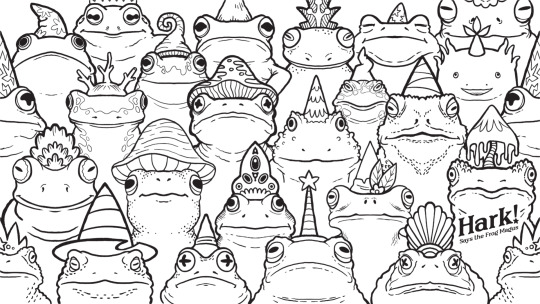
63 notes
·
View notes
Text
I'm so excited to see how folks play and use BEFORE THE START, my new lightweight RPG. Here's a quick explainer video I put together this morning.
Links below...
10 notes
·
View notes
Text
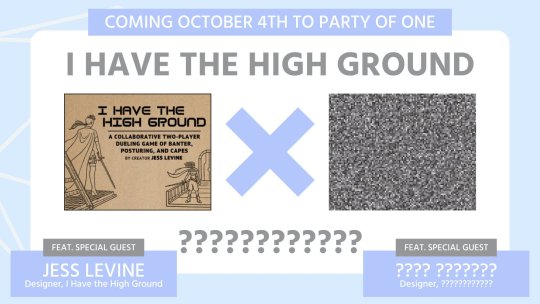
October 4th. Party of One brings you a special TTRPG collaboration unlike any other.
Two special guests, two of my favorite designers in the world, sit down together, one-on-one to mash up their games to see what happens.
PARTY OF ONE PRESENTS
I HAVE THE HIGH GROUND X ????????????
Feat @jessfromonline and a special surprise guest!
73 notes
·
View notes
Text
Announcing BEFORE THE START

BEFORE THE START is a story-starting, story-supporting, and story-telling toolkit to be used with any tabletop RPG.
It's also a standalone roleplaying game about community, calamity, and the small moments that define us.

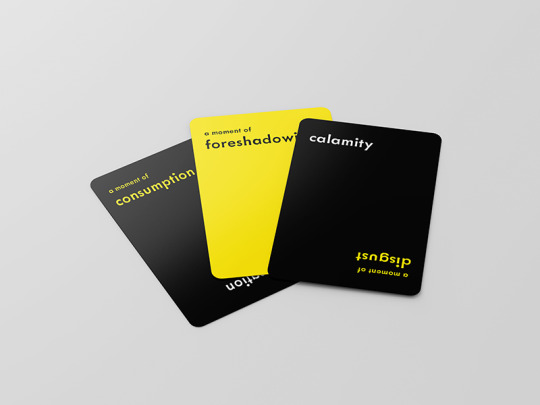
BEFORE THE START comes in two parts:
A beautifully minimalist deck of 72 cards used to create unique settings, robust characters, & tense situations.
A book full of rules, guidelines, uses, & play samples that will drive your creative games.
To get a taste of how BEFORE THE START feels at the table, check out this Tumblr post that breaks down how players build prologues using the foreshadowing cards:
The game will be released in digital & physical formats in October.
The digital PDF will include both print-and-play cards & a guide for playing using a standard deck of 52 playing cards.
You can pre-order it on Itch for just $2:
You can order the physical cards and book from my shop. (I'm currently selling the game at a discount to help cover production costs.)
19 notes
·
View notes
Text

CHEAP GAMES!!!
I'm restocking my 4 most popular games.
You can pre-order them now, get big discounts, & help me pay for October's reprints!
Plus, there are two brand-new-and-not-yet-officially-announced games in the shop!)
16 notes
·
View notes
Text
It's just been one thing after another lately and now I'm stuck away from home with a car that needs fixed. Any help sharing this around would be really nice. I need a "w."
62 notes
·
View notes
Text
The Lost Bay - First Look Release
Your one-way ticket for the 90s that never were.
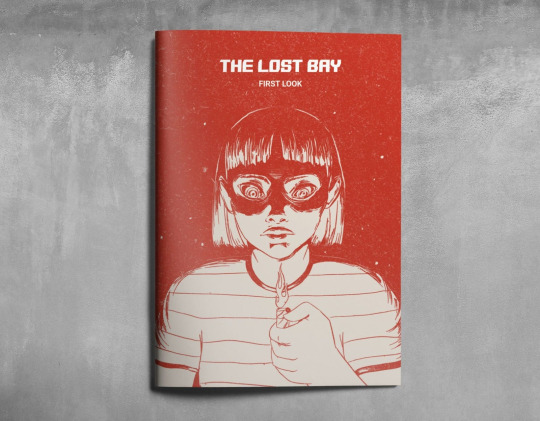
Today is the day! after countless play tests and tweaks The Lost Bay - First Look has been released digitally. In it you play as a young person touched by the Weird, an ancient force that gives you supernatural powers. You roam the Bay with your gang, its malls, arcade games shops, skateparks and beaches, and fight the Horror that has awakened.
Key features of the game:
1. You play Vibes. Each vibe has a distinct flavor and set of powers. You can play as Splinter, Screamer, Scanner, Firestarter, and many more. Vibes are granted custom growth opportunities: every time they fail at using a power they get a Scar, and this can include getting new powers, or discovering something about the Bay.

2.The lore of The Lost Bay is spread throughout the ruleset, tables, and game procedures. You’ll discover it as you create your character and play, without having to read boring lore text blocks. The lore of the Bay is embedded in the items, powers, Scars and NPCs you’ll encounter.
3.Open and play. Three attributes, two resources to manage (Heart and Weird), one mechanic to rule it all: a D6 dice pool. If you have a basic knowledge of tabletop RPGs you’ll need fifteen minutes to familiarize yourself with the ruleset.
GET THE LOST BAY FIRST LOOK
4.Weird is cool. And there’s a lot of it in the Bay: cults, curses, relics, and Living Saints. The Lost Bay is both a familiar playground and an uncanny world that portrays an alternate version of the 90s. It’s wicked enough to give you the chills, and it’s open enough for you to expand it the way you like.
Why the 90s?
Because they’re a decade where the ancient analog world mixes with the modern digital one. This mix creates infinite clashes and conflicts, ideal to spark tabletop RPG adventures, and horror stories.
The Bay itself is the incarnation of this contrast. Ancient creatures and forces dwell right next to modern technology and buildings. Even the playable characters embody this duality: they are archetypes inspired by the late 80s/90s media and culture, but their powers derive from the ancient and mysterious forces.

What you’ll get in the First Look edition?
Spooky Locations
Scary MOFOs
Supernatural Horror
Powerful Vibes
Loads of items
Relics
Living Saints and immortals
Story sparks
VHS, arcade games, skateboards, evil cults, demons, ghosts, blood and fear.
You can get the First look edition right now at an affordable price. The game PDF is updated on a weekly basis, and its price will increase as new sections are added. Meaning that the earliest you get it, the less you’ll pay for it. Pretty neat right? Funds collected will allow commissioning more art from Evangeline Gallagher and to pay for editing.
Have you ever wanted to play a zombie or a ghost? Now you can!
This week’s update features two new Vibes (playable character classes): the Half-Dead, and the Spirit. To unlock them you have to die first, and if you’re lucky enough you’ll become a Reborn. You might even get a Zombie cat pet.
MINIDUNGEON
If you have little time on your hands and are looking for a ready to play horror adventure compatible with The Lost Bay check UNIT DH-17. This suburban horror mini dungeon has been updated to fit The Lost Bay ruleset.
You can also get them both as a bundle with a 20% discount here https://itch.io/s/99423/the-lost-bay-rules-adventure
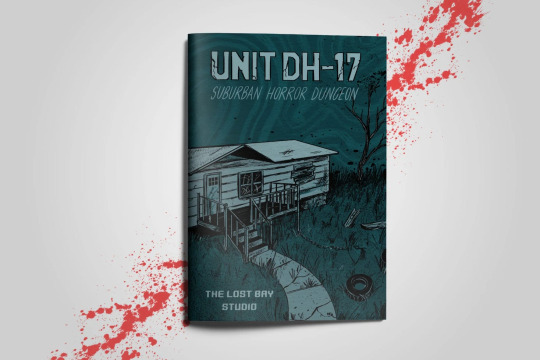
Weird is beautiful
Want to know where this game comes from, what it’s really about?
I grew up in an environment where toxic masculinity was the rule. Both at home, and outside of it. And by toxic, I mean horror-movie level toxic. Murders, blood and all. That was just the way things were, the world of the grown ups. Normalcy. I didn’t find that normal at all! I was pretty scared most of the time. But I was lucky enough to be part of a gang of kind souls. We loved each other and helped us survive the harsh world of the Bay. We were Geeks, Punks, Queers and Dreamers. The normies called us Weird. At first that felt hurtful, and it took me years to understand that being “Weird” is more than ok, that “Weird” is beautiful. Eventually, I made “Weird” my one-word motto, and used to wear a Why be normal? pin. I was proud of my Weirdness. Things felt better, the Bay was my playground, I loved its marshes, forests, beaches and skateparks. I was happy.
Then one day, something unexpected happened. I had to leave the Bay, without notice. Like in the movies. At dawn, hiding, in secret. I didn’t come back for more than 15 years. During that exile the Bay grew in my mind like a place of fantasy, and actual memories blended with fiction. The Lost Bay became a dream, partly familiar, partly alien, a place of wonder shrouded in a terrifying mystery.
TAKE ME TO THE LOST BAY
The Lost Bay - First Look is the travel guide to this wondrous and wicked place I’m offering to you. If you accept the invitation you’ll play beautiful and powerful characters, you’ll fight the horror in breathtaking combats, and rewrite the Lost Bay’s history.
98 notes
·
View notes
Text
this is officially going to be a #Diedream hack.
MAGNETIC RESONANCE
i'm coming to terms with a new disability.
on tuesday, while i lay quietly in a screaming tube that temporarily realigned the water particles inside my body, i had time to let my mind wander.
so...

announcing it here. hoping to have it done by the weekend.
9 notes
·
View notes
Note
❄️
❄️Share a piece of flavour text from a game you’re working on.
from ask game for ttrpg projects
i love this one:

I have no idea if it's going to survive -- it probably won't -- but right now this text appears on one of the first pages for the BEFORE THE START book.
I'm trying to explain how the player should feel empowered to take a look at the game's cards and decide how they want to use them. The book gives them lots of ways to play with them, but they probably have great ideas.
Q-tips aren't made for cleaning ears. But we figured out a great use for them. Q-tips discourage us from using them that way, but we can do what we want. Something like that. Still working it out.
-------
Ask me more ttrpg project questions!
5 notes
·
View notes
Text
MAGNETIC RESONANCE
i'm coming to terms with a new disability.
on tuesday, while i lay quietly in a screaming tube that temporarily realigned the water particles inside my body, i had time to let my mind wander.
so...

announcing it here. hoping to have it done by the weekend.
9 notes
·
View notes
Text
Werewolf: the Apocalypse 5th Edition and the Anti-Indigeneity in the Gaming Industry
reosted with permission from J.F. Sambrano
Dagot’ee!
Shii J.F. Sambrano gonsēē. My nations are Chiricahua Apache (Ndeh) through my maternal grandmother and Cora Indian (Náayarite) through my maternal grandfather. I am a mixed race Indigenous person, and through my father my heritage is English and Scottish. I am currently residing and doing work in my community on the lands of Lummi Nation. I use both gender non-binary and masculine pronouns, but prefer the former. I have several published works in the TTRPG industry, and am probably most known for my contributions to Mage: the Ascension 20th Edition, Werewolf: the Apocalypse 20th Edition, and the Transformers Roleplaying Game, as well as being part of the Essence 20 development team. Further, I also work in higher education at an Indian college, both advising and teaching Indigenous students across the United States. My passion is education, and I believe that we all learn through play, and that TTRPGs are a valuable source of learning, especially on personal, cultural, and social levels. This has always been what has drawn me to TTRPGs since I started playing M.E.R.P. with my brother in 1996 (and before that HeroQuest), through to my “graduation” into more story-driven games such as those presented in the Storyteller System, until now, where I author and produce my own roleplaying games.
I was also part of the First Team (in-joke intentional) hired by White Wolf Studios/Paradox Interactive via Hunters Entertainment to develop and author Werewolf: the Apocalypse 5th Edition. After several months of work, Paradox Interactive chose to go in another direction in early 2021 (I believe it was either March or April) and in fall of that year, it was announced that Werewolf would instead be taken in house, with Justin Achilli as the Brand Creative Lead and primary author of the book. Going forward I will be describing my experience while I worked with Paradox Interactive, primarily through Karim Muammar, White Wolf’s Brand Editor, as well as the developmental editor for Werewolf. Although I worked in a team, both with hired authors and in-house representatives at Hunters Entertainment, I will not be speaking for the experience of others, except when specifically noting unanimous consensuses, and specific interactions (which will go unnamed) that are particularly relevant. My hope is that by highlighting some of the anti-Indigenous attitudes that are central to the foundational members and leaders of the White Wolf brand, that I can provide opportunities for growth and healing within the World of Darkness TTRPG community, but also in the broader gaming community, where these behaviors and attitudes are rampant. I also want the community to have a better understanding of what this experience is like internally, and the challenges that Indigenous creators, as well as other marginalized creators, are met with when they try to make positive change within nerd and geek communities clinging to inherited white supremacist values, even if they don’t realize they are doing so.
What I do not want to be doing in this article is creating fuel for edition wars. I believe that both legacy and Werewolf 5th are rife with anti-Indigenous attitudes, and appalling amounts of appropriation. Both versions deserve criticism, I am not defending one over the other, I am only sharing what my experience was like working on the 5th edition of the book. Further, please understand that I was originally going to wait until I had read the final copy of the book, because I wanted to know how much of my work was used (based on previews I already know some was, just not the extent) and whether or not they decided to credit me for that work, and how I was going to be credited. My belief is that I likely will not be, but I am genuinely uncertain. Knowing how they handled that would have reframed how I addressed this. But more importantly, I want it to be very clear that even before Paradox ultimately pulled the plug on the Hunters team, I was preparing to exit working on the project based on the experience I will describe below. Not only did I find it frustrating, and personally disparaging, but I ultimately decided I was uncomfortable with my name being attached to the product based on the direction they wanted to go. So while I wanted to know whether or not I would be credited, because it would teach me something about their internal practices, I do not want or need the credit.
Finally, the reason that I decided to speak about this now instead of after having a chance to inspect the final product, was because my personal experience dealing with anti-Indigeneity coming from Paradox was just that: personal. But since then I have witnessed a throughline of hateful and xenophobic attitudes wielded against Indigenous people across the globe, and we do not deserve this treatment. I was outraged over the events that led to the segregation of the Latin American fanbase, which culminated from bottom-up criticism about how poorly their people and countries were being defined through World of Darkness products, and ended up with the firing of their Latin American Brand Ambassador, Alessa Torres, because she chose to stand with her community in those criticisms. I was further appalled when the likeness of Tāme Wairere Iti was shoehorned into the Werewolf book, a blatant example of cultural theft: not only in stealing the literal physical identity of an Indigenous person, but also his sacred tā moko. When Paradox Interactive issued an apology for this, it felt incredibly hollow to me in the wake of these events, the hateful attitudes I had personally witnessed coming from the top.
Whether from North America, Mexico, Brazil, Argentina, or Peru, or across the globe in New Zealand, not only do Indigenous people deserve better treatment from such a major company, but their Indigenous and Latino fanbases, who have twisted and worked themselves through difficult representation for decades at this point, deserve better. Apologies are not enough, especially when they come with next to no real change.
Werewolf: the Apocalypse in Context
At the time that White Wolf Publishing began to produce its World of Darkness line, the TTRPG industry was dominated by white men, both as producers, developers, and authors, as well as the main characters in their settings. White Wolf's World of Darkness made an impact at the time, by defying these Eurocentric, patriarchal presentations, first by defaulting to feminine pronouns throughout Vampire: the Masquerade, and then by focusing on Indigenous representation and values in Werewolf: the Apocalypse, and as a young Indigenous nerd, it had a positive impact on me, as I know it has on some other Indigenous people who became fans of the World of Darkness at the time. This was because before opening the pages of Werewolf: the Apocalypse, I had never seen heroes that I could play who looked like me and my culture. It was off, and often offensive, but it was my first experience in which I could directly play a hero who shared my heritage--and I also had more than one option through two different Tribes to do so. This might sound a little like I was cheering for table scraps, but again, at the time, table scraps was more than I had ever seen before.
Werewolf: the Apocalypse 1st Edition was originally published in 1992 via then White Wolf Publishing (not to be confused with Paradox Interactive's White Wolf). From its inception, the premise was interwoven with what its then-authors believed to be Indigenous praxis and representation. Like many pop-culture presentations of Indigeneity from this time period (see Fern Gully, Dances With Wolves, Disney’s Pocahontas, or in TTRPGs, the NAN from Shadowrun) it was rife with problematic and even offensive stereotyping. The most obvious examples thereof are within the two "Pure Tribes" Uktena, and W****** who I will henceforth refer to as Older and Younger Brother. However, Indigenous inspiration was at the core of the game's spiritual premise as well, where animism and "Totems" are central to the setting and gameplay. The way these concepts are presented is trivializing and dehumanizing, but it is important to acknowledge that the appropriation present in Werewolf: the Apocalypse goes a lot deeper than the two Brother Tribes (even the term "Tribe" was meant to invoke a vision of Indigeneity compared to the previous setting in the line's use of "Clan"). Additionally, there is art throughout every generation of these gaming books that represents humans, wolves, and human-wolf hybrid forms wearing Indigenous regalia, including sacred items such as headdresses, or engaged in sacred rituals such as the Sun Dance. The list of problematic representations goes deep, and my examples only scratch the surface, but it is also important for me to note the positive impact that this had, particularly in the 90's.
Even though the primary contributors to these narratives were non-Indigenous authors, or in one case, a Pretendian, and another, a culturally disconnected author, by the time the Revised (or Third Edition) era of the books came around, White Wolf Publishing was actively engaged in cultural consultation. While I do not believe cultural consultation makes a big difference on its own, it matters that the attempt was made, to a degree: while these efforts fall short of what needs to be seen in cultural representation, this was still ahead of most other gaming companies at this time.
Hired by Hunters Entertainment
In February of 2020 I was approached by one of the co-owners of Hunters Entertainment to be one of the primary authors for Werewolf: 5th Edition due to my work on other World of Darkness projects, and let's be honest, because I was capable of bringing a much needed Indigenous perspective to a gameline that was rooted in Indigeneity and rotting with appropriation and racist stereotypes. I was overall receptive to the invitation, largely because I was very passionate about the World of Darkness setting overall, and Werewolf in particular, due to the impact that 90's representation had on me when I was a younger gamer. I also felt hopeful that with a really hard rewrite of Indigenous aspects of the game that I could shift a lot of really painful aspects of the game into something that was a net positive for Indigenous representation. I will tell you now, more than anything, I was excited to rewrite the Younger Brother Tribe, because when separated from racist authors, their message is very empowering and real to my lived experience.
That said, I did not agree to join the project without first asking for reassurances. I said that I was not willing to write negative Native stereotypes. I would not use appropriative language, or generally engage in appropriative writing (which meant at minimum that the names of the Pure Tribes would need to change), and most importantly, that I would not not engage in writing that contributed to erasure. While the person who recruited me to work on the project was eager to work with me, he acknowledged that he was not sure he could get everything I wanted to see approved, but also promised to fight for everything I suggested as hard as he could. Additionally, he shared with me that the original setting pitch for W5 involved all of Younger Brother being slaughtered en masse in a massacre. I made it clear that this was exactly the kind of thing that I would not write. I cannot remember if this was something he suggested to be changed before or after I was invited onto the project, but with some pushback it was changed. However, I point this out because I want you, the reader, to understand how eager Paradox Interactive was to start with mass genocide and erasure as a foundation to the setting. All that said, I cannot stress enough that I have had nothing but positive experiences with Hunters Entertainment, and none of the following concerns fall upon them.
The Sword of Heimdall
The first encounter the Hunters Entertainment team as a whole had with problematic guidelines for the W5 draft was the direction that Paradox Interactive wanted to go with the Sword of Heimdall. At the time, the suggestions from Paradox and Karim Muammar were that the Sword of Heimdall was going to represent the new major villain of the Werewolf setting, and that they were to also represent the far-right, fascist direction that Werewolf society so often turned toward. They were meant to be representative of how far the new concept of Hauglosk could take entire communities. However, the Sword of Heimdall was discussed interchangeably with the Get of Fenris as a whole, and more than once Muammar seemed to suggest that every member of this Tribe was guilty of the same attitudes espoused in previous editions from the Sword of Heimdall. Now let's not beat around the bush: the Sword of Heimdall are literal Nazis. They believe directly in white supremacy and don't shy from it. They wanted to cleanse impure elements from the Get of Fenris, including BIPOC people, other non-white ethnicities, women, neurodivergent Garou, and other disabled Garou.
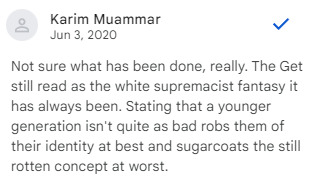
The writing team found this approach problematic for several reasons. The first, and most obvious, was that the direction seemed to want to turn one of the most popular Tribes into a horrific stereotype of its most abhorrent faction. Whether or not Muammar’s goal was to turn them into villains, we could not imagine a world where fans of previous editions would get their hands on this book, and not look for a way to play one of their previous favorite groups, thus creating the issue of making a guide to playing Nazi. Even beyond that, it’s not as if historically there were not players who used the tools of the setting to play Black Spiral Dancers, why wouldn’t this draw people who actually wanted to role-play through these toxic, harmful politics? Further, and while this is less important, it left a bad taste in my mouth, the justification for this major shift in Werewolf lore seemed to change over each pass. At first, Muammar suggested that all Fenrir were Nazis/SoH. Then, when he was provided with evidence that it was a small faction that was eliminated in the early 2000’s, he started to shift toward the idea that we should not follow the lore. Finally, when every single member of the writer’s team flatly refused to provide what would essentially be “a player’s guide to being a Nazi werewolf” the writing was on the wall about the end of our involvement with this product. More than once, he suggested that we were cowardly social justice warriors for being unwilling to work with this concept, even though there were several attempts to write a heroic version of the Fenrir that were focused on undoing these ills of the past.
Indigenous Erasure in Werewolf: 5th Edition
While the entire Hunters Entertainment writing team was handling the major, glaring issue of Paradox’s fervor to include a major Nazi element in Werewolf, I was personally dealing with the problematic approach to the Indigenous issues in the setting. The largest problem, for me, was in addressing Younger Brother’s issues, the history of non-Indigenous writers creating horrifically racist stereotypes, and what was valuable in the Tribal identity that should be saved and recentered. However, my attempts to do so were thwarted with every approach. I rewrote this Tribe four times, and offered three different versions of it to try to earn approval for a final write-up, but each time there was a lot of negativity directed towards my attempts and all them boiled down to this: Muammar felt that having two Tribes (both Younger and Older Brother) representing the “Indigenous population” was too many, and wanted them to only be focused on Older Brother, and that Younger Brother’s connection to a central, Indigenous identity, was undesirable because “other sources wrote them as having Siberian and European connections” and that future writing on this Tribe would require a lot of sensitivity…suggesting that one, Muammar wasn’t interested in doing the work to handle that level of sensitivity, and further, that he wasn’t interested in including me in future work, since I was involved with doing that at the time.

I want to take a moment to remind you that the work that was put into recovering Younger Brother started with “Let’s Kill Them Off” and at this point, through a combination of convincing and pleading, had been walked back to “They can live, but now they’re not connected to being Indigenous anymore” which is just representative genocide of a different variety. “Kill the Indian in him, and save the man.” It was also explicitly something I said I would not write about going into this project. Ultimately, my efforts did not get much further than this, with some specific exceptions I will cite below.
Karim Muammar’s Anti-Indigenous Positions
Muammar consistently and repeatedly communicated to the team in ways that were condescending and dismissive of our collective accomplishments and capabilities, but from my perspective, no one suffered as much significant derision as I did while discussing the changes I wanted to make to Younger and Older Brother in order to make their representation empowering and exciting.
In the pulled quote from the previous paragraph, I want to point out to you that Muammar, who had the title of Lead Editor on this project, refused to capitalize Native American. Further, he would often redline my work with edits to decapitalize my own uses of Native American, as well as the word Indigenous when referring to Indigenous peoples. While there are plenty of people who might want to argue about this, I will point out that both the AP style guide as well as the Chicago style guide (the one which I am most familiar with in my academic historical work) both call for Indigenous to be capitalized when referring to a people. Further, I challenge anyone to defend the consistent decapitalization of Native American. More importantly, the reason that these are standards in respected style guides, is because the English language has been used historically to oppress and erase ethnic identities, including Indigenous identities. By transforming adjectives into proper nouns, we are declaring that Indigenous and Native aren’t descriptors that can be applied to animals, plants, and soil, but real lived identities and culture groups.
When I was explaining to the Paradox team (which was mostly just Muammar) why it was important to change the names of these two Tribes from the appropriative (and offensive) ones used in the past, Muammar pushed back by defending the previously used Younger Brother name, even after reading my extensive research and explanation about how this would harm Indigenous communities and fans.
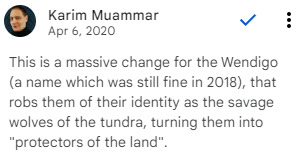
While doing so, he also decided that it was appropriate to refer to this entirely Native American tribe by the word “savages” a slur that has been specifically used to dehumanize Native Americans, and then mocked my rewrite that focused on presenting them as stewards of the land using Indigenous methodologies and praxes, instead of the “savage” racist stereotypes they were presented as in previous editions. Further, as in the above quote, even after it was communicated that the use of this term was problematic, he kept doubling-down to use it to refer to the Tribe.
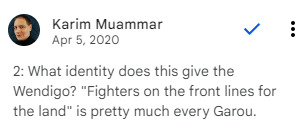
Even though I worked hard to redefine Younger Brother through Indigenous theory, such as place-based theory, relational theory, and communal theory, Muammar either refused to recognize this work, dismissing it as simple, or else simply could not understand the importance of these changes. Either way, the choice is that he didn’t want them to change, or couldn’t comprehend why the change was important because of how entrenched in white supremacist thinking he is. Further, after the massive effort that I put forward to attempt to educate him and the rest of the Paradox team on these issues, the insistence on using offensive terms and belittling my work felt intentional. So let’s talk about the work I did that was above and beyond my job description: free cultural consulting work.
“Sensitivity” and Consultation
I have seen several misunderstandings of my role working on this project going around, so I want to make something very clear. I was hired to work on this project as an author, and nothing else. I was not ever hired to be a cultural consultant. I do not do cultural consulting work. While I feel that there are many creators and companies who hire cultural consultants with the best intentions in mind, their responses often fall short of what is needed, as no one is ever obligated to actually follow the advice of cultural consultants. Further, I think there are also many companies who choose to hire cultural consultants only to say “we did this minimal step, and that is enough” in order to ward off naysayers.
However, anyone who hires me gets some level of cultural consulting for free, because it comes out in my writing–in both what I won’t write and what I choose to center my writing around. In the case of Werewolf 5th Edition, however, it was far more involved than this. I came with a plethora of “I will not write X” because I knew the setting was so problematic. A short list of my demands besides not being willing to write Indigenous erasure, was that we needed to change the names of the Pure Tribes (and the term Pure Tribe itself), we needed to change the word Totem to Patron, and also the Patrons of the Pure Tribes. We needed to move away from the term Metis for obvious reasons, and we needed to move away from the term Skin Dancers. I also specifically noted that there was a lot of cultural theft happening from the beginning of Werewolf until now that I wanted to address. The only way these issues were going to be addressed was to convince Paradox they were actual issues on the level of PR concerns, because nothing else was likely going to be considered. So in order to achieve this, I put in weeks worth of research, writing, and meetings with top level administrators with Hunters Entertainment so that they could bring this information to Paradox. I never documented my hours, but I would guess that I did approximately 80-100 hours of what I could only describe as cultural consultation work for free that was outside the contract work I was hired for. Let’s be clear: I did this willingly because I was passionate about the positive changes I wanted to see in this product, because I believed that Werewolf’s historic ills could be turned toward non-toxic representation.
Besides my actual words, such as naming the Ghost Council, and arguably the name Gale Stalkers came from a combination of names I pitched to Paradox after Winter’s Teeth was denied, and several sentences and paragraphs that I have seen so far that appear so close to what I originally wrote that you could imagine they were just edited versions, my largest contribution toward the final version of Werewolf: 5th Edition was this work. The only reason the offensive, appropriated names were changed were because of hours of my work to convince them it needed to happen. The reason that the Gale Stalkers aren’t just dead and gone: again, I pushed against this. The reason that Skin Dancers, Totem, and Metis will not appear as canonical titles? I pushed against their unwillingness to alter these things (see Karim’s defense of Wen**** Tribe name above).
Further, and this is the biggest reason I decided to write this article before seeing the final version of the book, I want to mention that I was also included in discussions with Hunters Entertainment to potentially be part of the art direction team, especially to oversee depictions of Indigenous characters, regalia, and art, to ensure that it would be represented either respectfully or not at all. I decided I needed to speak as soon as possible after the artistic portrayal of Tāme Iti appeared in the Glass Walkers preview without his permission. There are many arguments surrounding this issue and I am not going to address everything, but ultimately, I can tell you that had I remained as part of the art direction team, and saw that, I would have questioned it immediately. Even if I didn’t recognize Tāme Iti immediately, I would have asked what the source was on the depiction of moko in that piece, because I am aware that this is a sacred form of art–and I had already discussed wanting to make sure things like Crinos in headdresses didn’t appear in the book (as had often happened in previous editions, particularly on a certain white-skinned character whose name rhymes with Steals-the-Past).
As time working on this project went on, and I went through rounds and rounds of trying to convince Muammar and Paradox that it was important to not steal Indigenous identities, art, and stories, and that a greater effort needed to be put in powerful and empowering Indigenous representation, and I constantly ran into refusals and criticisms that were clearly hateful toward Indigenous identities and peoples, not to mention the push to represent Nazism as a major part of the game setting, I grew increasingly frustrated and restless with feeling like I was trying to work on a challenging project while also defending my right to exist as the person I am at every turn. Eventually I turned to another Indigenous TTRPG and game creator to ask for advice, and after a long and difficult discussion, I came to the conclusion that I was going to talk to the Hunters administration team and tell them that if Muammar kept using slurs and other anti-Indigenous language and attitudes, I was going to need to step off of this project, because it was harmful to me on a personal level. In furtherance of this point, I have been avoiding doing any contract work at all where I can tell that I am wanted for my specific cultural perspective ever since, because this situation was so harrowing for me.
Unfortunately, before I could have this conversation, after one final draft of Younger Brother and Bone Gnawers (which had its own issues, but that is not the point of this discussion), before we received any other specific feedback, the Hunters Entertainment administrators announced to the writing team that Paradox had decided to take the book in-house, and would no longer need our services.
The main point I would like to leave you with, besides these few specific quotes (out of dozens and dozens) that Muammar made that were anti-Indigenous, is that there is often a big call to have more BIPOC voices in various entertainment industries, so that both our stories, perspectives, and unique views on how the universe and life works, can be included; so that an industry that is historically, harmfully Eurocentric, might turn toward new, healthier, and inclusive directions. And I agree with this call for change, but I implore you to consider the conditions that BIPOC creators often have to work under: doing cultural/identity work and consultation for free as part of being present, being subject to vicious refusals of our experiences and perspectives, and straight-up having slurs lodged against our work. I want to see these changes in the industries we love, including the gaming industry, but currently the people who are in charge, who have the most power, are severely hostile to our work and our perspectives. This is why, for example, works like Coyote & Crow were done with an almost entirely Indigenous group of creators, and led by Indigenous creators, because trying to work for and with this ugly, hateful, and xenophobic group of people is so often exhausting, both mentally and spiritually, and because no good changes end up being made.
I am glad the harmful, appropriative terms were removed from the setting. I am glad I was part of the fight to make that real. I am not so glad that I was treated with hostility and racism by Muammar for the effort and love I put into this work, and I am not so glad that I will certainly be reviled by one of the two communities I did this work for–the gaming community, and certainly the people in power in this industry–and I am also not so glad that I didn’t have the opportunity to properly acknowledge how much of Werewolf’s base themes and setting are twisted and tied-up in Indigenous appropriation without giving the proper acknowledgments.
More than anything, I hope that this story will help you, the fans, realize that there is a lot of darkness in these communities, and they won’t change unless you hold their feet to the fire.
Ánaagodzįįhł
J.F. Sambrano
3K notes
·
View notes
Text
You won’t believe how big the jellyfish are in this episode.
(They’re, like, very huge.)
New Episode: Grasping Nettles with Carlos Cisco
A community is a living thing. It grows, it splits, it thrives, it perishes. … All of this is even more true when the community is INSIDE OF a living thing.
You'll dig this episode if you like: Weird sci-fi, Osmosis Jones, critical worldbuilding, smart characterization, and fun interaction between good friends.
30 notes
·
View notes
Text
I want to be like Aaron when I grow up.
This is outageously cool.
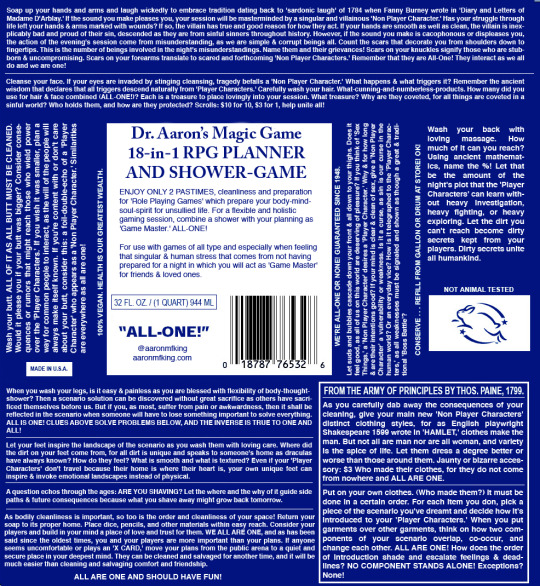
Thank you to the absolute weirdos who download this game. There are one or two of you a week. I originally had dreams to print it on a big shower curtain, but, well, that's expensive. And where am I gonna store a bunch of shower curtains?
Dr. Aaron's Magic Game 18-in-1 RPG Planner & Shower Game is a game to play in the shower before you run an RPG. It helps you plan NPCs and conflicts and stuff. It will also cleanse your body and soul.
164 notes
·
View notes
Text
I’m learning!
if you’re a new tumblr user from tiktok or IG or something and only like posts and dont reblog them yeah people will think you’re a bot and block you but you will also make this website actively worse. they want “algorithmic” users like you, served recommended posts through likes, not people who just follow each other and respond to the direct chronological feed. there is a reason this website is still better than the rest, even with all its problems, do not ruin this
105K notes
·
View notes
Note
🌤️
🌤️ Share your favorite mechanic from a game you’re working on.
from ask game for ttrpg projects
BEFORE THE START is my new card-based storytelling toolkit & standalone ttrpg.
Players can use the cards in many different ways. One of my favorites is to create a prologue -- a series of short little scenes that build to the BIG EVENT that launches a campaign.
(As an example, let's say that the big event is a catastrophic earthquake that will level a city.)
After loosely sketching out that event, each player receives a hand of cards.

Black cards invite the player to narrate a small moment focused on their character. Yellow cards invite the player to foreshadow the big event. When a player takes a turn, they can play a black card, a yellow card, or both.
I want to talk about these yellow cards.
When a player plays a yellow card with a black card, they incorporate foreshadowing elements into their character's scene.

Let’s stick with our earthquake example. The player is developing the character of Dee, who works as a custodian at the city’s premier art museum.
“It’s night. Dee is hard at work cleaning the museum after all the visitors have left. We’re in an grand foyer, lit by an enormous antique chandelier that hangs in the center of the space. We hear the drone of a commercial floor scrubber as Dee steers it around the tile floor. Shadows start to shift, ever so subtly, and we hear the tinkling of glass. Dee shuts down the scrubber and looks up to watch the chandelier sway, the hundreds of lights in a kaleidoscopic dance. Her eyes are wide, and she’s smiling, but her expression stars to shift to concern as the movement of the chandelier becomes more violent, the swaying more extreme.”
When a player chooses to play a yellow card by itself, the spotlight shifts away from the character. The player can focus on the setting, develop details about the situation, and even introduce a new NPC.

Continuing our example:
“We see a seismograph’s pen scrawling peaks and valleys across a rolling sheet of paper. Each movement gets more chaotic, more extreme. In front of the device, in a cheap rolling chair, is a white-coated scientist, totally asleep, an empty coffee mug dangling from her fingers. The lights in the lab flicker and go out. And now we’re overlooking the entire city as waves of blackouts roll through neighborhoods. Sudden darkness from the windows of apartment buildings. Street lights. Neon signs from late night cafes. Digital billboards attached to skyscrapers. When the entire city is dark, we can see starlight in the night sky.”
I’m always excited to see how fast new players “get” how to emply these foreshadowing cards. The storytelling becomes dynamic, the camera is swift and shifty, and we get to discover more about this big event that’s going to launch our story.
----
So yeah, that’s a little bit about BEFORE THE START, which I’ll be releasing in September.
Ask me more ttrpg project questions!
28 notes
·
View notes
